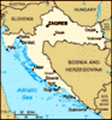Advertisement
Published: September 16th 2017
Leaving Sibernik yesterday morning, we headed for Plitvice Lakes National Park, which is one of the oldest national parks in Southeast Europe and the largest national park in Croatia.
In 1979, Plitvice Lakes National Park was added to the UNESCO World Heritage register. The national park was founded in 1949 and is situated in the mountainous karst area of central Croatia, at the border to Bosnia and Herzgovina. The protected area extends over 296.85 square kilometres (73,350 acres). Each year, more than 1 million visitors are recorded. The national park is world-famous for its lakes arranged in cascades. Currently, 16 lakes can be seen from the surface. The lakes collectively cover an area of about two square kilometres (0.77 square miles), with the water exiting from the lowest lake forming the Korana River.
We arrived at our apartment in Grabovac just prior to lunch, and the owners kindly allowed us to quickly check in, and we then enjoyed a sumptuous lunch at a local restaurant.
A quick check of Google revealed Plitvice Lakes Entrance 1 to be the recommended gate for a half day visit to the park. We commenced walking the
very well constructed and maintained boardwalks and paths, which take you to each key vantage (photo opportunity) point. After finishing what we had initially thought was a reasonable half day walk around the lower lake system in around two hours, and being taken across the lake on a ferry for our bus trip back to the carpark, we were feeling good, so we hiked back to the Entrance 1 Carpark (rather than take the free bus on offer) via the edge of the lower lakes. The travertine waterfalls and clear blue lakes were pretty amazing to see on a sunny day (apparently a rarity in Plitvice), and we are hoping the predicted rain for tomorrow holds off so that we can walk the upper lake system.
After being presented by our hosts with an array of home style produce for breakfast, such that we couldn’t possibly consume it all, we headed out for day two with our rain coats at the ready. First though, we sought out a local castle that was signposted near where we were staying. The town of Dresnik was mentioned for the first time in the 12
th century, and Stari Grad Dresnik Castle
was located at it’s centre. The castle was captured by the Turks in 1592, and was only liberated at the end of the 17
th century. The castle overlooks the gorge through which flows the Korana River, however, there didn’t appear to be any water in the river. I mentioned earlier that the water from the Plitvice Lake System flows into this river.
It was lightly sprinkling when we set out from Entrance Two, so we donned our raincoats, and caught the bus to the top end of the lake system. The rain stopped and there was only the occasional spot of mist rain, which really didn’t affect our walking, in fact, it made it a pleasant temperature to walk. If we were to recommend one of the two lake systems to walk, we would recommend the upper lake system, which is accessed from Entrance 2, and to purchase a two day pass and visit the lakes system over two days. This allows you to take your time walking, and appreciate the beauty of Plitvice, and stopping for the many photo opportunities.
The upper lakes system has more travertine waterfalls and more picturesque vantage points
for viewing the lakes and waterfalls. The board walks that have been constructed in the upper lakes are an engineering marvel, and being made of local timber, provide an earthy feel to the park. We are thankful that we took the time on our Croatian leg of our holiday to visit Plitvice Lakes. I still recall seeing the waterfalls featured on an episode of Getaway, and thought, one day I have to visit that place.
After exiting Plitvice Lakes NP, we headed back toward our accommodation, and a sign pointing to Korana Gorge and a Water Mill caught my eye. We made a small detour and located the gorge and the Water Mill. The Korana River, into which flows the full volume of the water that flows over the Plitvice Lakes waterfalls, was bone dry. I understand that sometimes rivers can flow underground, however, with the volume of water we witnessed, one would think there should at least be some water flowing in the Korana River. On one of the trails along the lake we had walked past what appeared to be a large Pump House, which was emitting a loud noise similar to a large water
pump system. It has been an exceptionally dry summer in Europe this year, with wildfires raging in several countries, including Croatia. Rome has even turned off it’s famous fountains to conserve water. Could it be that Plitvice Lakes National Park is dry season proofing Croatia’s most visited (and valuable) tourist destination by pumping the water exiting the Plitice system back up to the top of the lakes system, at the expense of the Korana River?
Advertisement
Tot: 0.318s; Tpl: 0.013s; cc: 9; qc: 48; dbt: 0.0813s; 1; m:domysql w:travelblog (10.17.0.13); sld: 1;
; mem: 1.1mb










